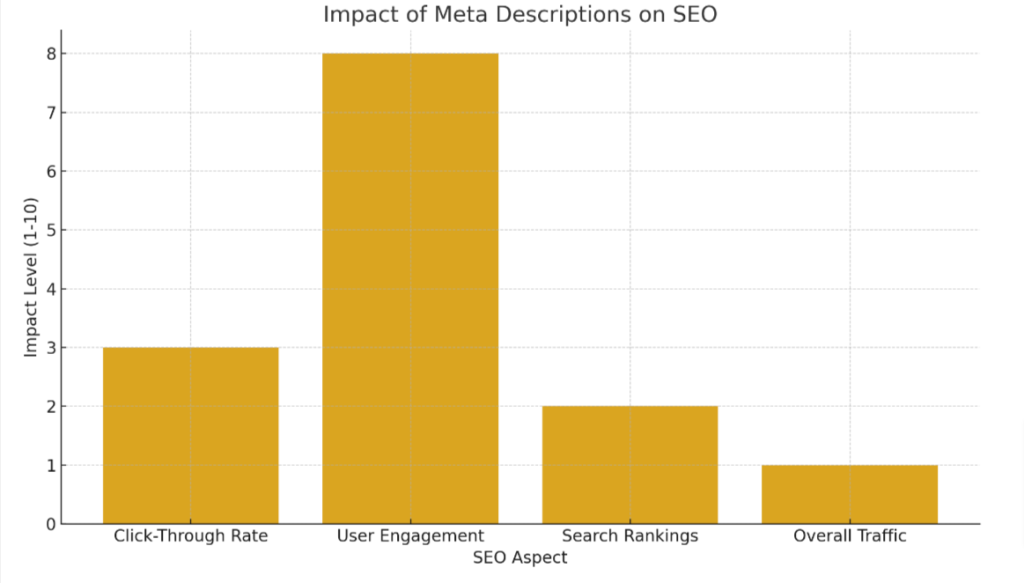Meta Descriptions: Your Secret Weapon in SEO Writing
Are you struggling to improve the visibility of your website on search engine results? Did you know that a well-crafted meta description can dramatically increase your click-through rate and organic traffic? This article is going to demystify the role of meta descriptions in SEO writing, sharing effective tips for optimized content and shedding light on common challenges.
Let’s unravel how this small yet powerful HTML element can make a major difference in optimizing your online presence.
Key Takeaways
- Meta descriptions are concise summaries of webpage content that appear in search results and play a crucial role in attracting users to click on the link.
- Well – crafted meta descriptions can improve search rankings by signaling to search engines that your page aligns with user queries, increasing visibility on Search Engine Results Pages (SERPs).
- Effective meta descriptions drive traffic and clicks to webpages by providing a preview of relevant content, enticing users to click and potentially convert into loyal visitors or customers.
- Writing compelling ad copy, incorporating relevant keywords, and avoiding duplicate descriptions are key best practices for optimizing meta descriptions.
What is a Meta Description?
A meta description is a concise summary of a webpage’s content that appears beneath the title in search results. It plays a vital role in attracting users to click on the link and visit the webpage.
For example, if you search for a recipe, the meta description might provide a brief overview of the ingredients and cooking instructions.
Definition and purpose
A meta description, in the realm of SEO writing, acts as a concise summary that previews the content of a web page. Search engines like Google often display these descriptions in search results to provide users with an idea about the webpage’s relevance and quality.
Effectively written meta descriptions aim to capture interest while including keywords relevant to the contents; this ultimately encourages more clicks and directs traffic towards your site.
They may not directly contribute to higher search ranks anymore, but they hold substantial value for user interaction by enhancing accessibility and comprehension of your content.
Examples of meta descriptions
Meta descriptions can drastically vary based on the webpage’s content and purpose. Here are a few noteworthy instances:
- E-commerce site: “Boost your style game with our chic dresses, perfect for office or weekend wear! Free shipping!”
- Food blog: “Indulge in delicious homemade pizza recipes that will make your tastebuds sing! Step-by-step recipes included.”
- News website: “Breaking news, expert analysis, and insightful opinions on global affairs from trusted journalists.”
- Fitness blog: “Discover fun workouts to get toned at home without any fancy gym equipment.”
- Marketing agency: “Increase your ROI with our cutting-edge digital marketing strategies tailored to reach your target audience.”
- Travel blog: “Embark on an unforgettable journey through picturesque landscapes with our detailed travel guides.”
The Importance of Meta Descriptions in SEO
Meta descriptions play a crucial role in SEO as they impact search rankings and drive traffic and clicks to a webpage.
How they impact search rankings
Meta descriptions play a pivotal role in affecting search rankings. Search engines like Google use these short summaries to understand the webpage’s content. When the meta description is relevant and contains targeted keywords, it signals to the search engine that your page aligns with users’ queries.
This results in higher visibility on Search Engine Results Pages (SERPs), directly impacting your website’s ranking. Even though meta descriptions aren’t officially listed as a ranking factor by Google, their influence on click-through rates makes them an essential part of SEO strategy.
Engaging meta descriptions compel web surfers to click on your link rather than others, increasing organic traffic and boosting your site’s overall ranking over time.
Role in drive traffic and clicks
Crafting effective meta descriptions plays a crucial role in driving traffic and clicks to your webpage. These concise snippets of text, displayed in search engine results, act as a preview for users to determine if your content is relevant to their search query.
A well-crafted meta description can entice users to click on your website, increasing your chances of converting them into loyal visitors or customers. By optimizing your meta descriptions with relevant keywords and compelling ad copy, you can improve your search engine visibility and attract organic traffic to your site.
Furthermore, an enticing meta description that accurately reflects the content of your webpage can also enhance user experience by providing them with a clear summary of what they can expect from clicking through.

How to Write Effective Meta Descriptions
To write effective meta descriptions, focus on crafting compelling ad copy that entices users to click. Use strong action verbs and highlight the unique value or benefit of your webpage content.
Avoid using generic phrases and instead create specific, relevant descriptions for each page. Additionally, make sure to stay within the character limit allowed by search engines and incorporate relevant keywords for SEO optimization.
Tips for writing compelling ad copy
Writing compelling ad copy is crucial when crafting meta descriptions for your webpages. By following these tips, you can optimize your meta descriptions to attract clicks and improve your search engine rankings:
- Use strong action verbs: Start your description with an action word that encourages readers to take action, such as “Discover,” “Learn,” or “Get.”
- Highlight unique selling points: Emphasize what sets your webpage apart from others by mentioning special features, benefits, or exclusive offers.
- Keep it concise: Stick to the recommended character limit (around 155-160 characters) to ensure that your entire description appears in the search results.
- Appeal to emotions: Connect with readers by evoking positive emotions or addressing their pain points and providing a solution.
- Include relevant keywords: Incorporate targeted keywords naturally within your description to improve visibility and relevance.
- Match user intent: Craft meta descriptions that align with what users are searching for, addressing their needs and queries directly.
- Test different variations: Experiment with different wording and formatting styles to see which versions generate higher click-through rates.
- Provide a clear call-to-action: Encourage users to click through by including phrases like “Read more,” “Shop now,” or “Get started.”
Best practices to avoid duplicate descriptions
To avoid duplicate descriptions and optimize your meta descriptions for SEO, follow these best practices:
- Use unique content: Each page should have a distinct meta description that accurately reflects the content and purpose of that specific page.
- Include relevant keywords: Incorporate targeted keywords in your meta descriptions to improve search engine visibility and increase the likelihood of appearing in relevant searches.
- Write compelling ad copy: Craft engaging and persuasive meta descriptions that entice users to click through to your webpage. Highlight unique selling points or key information that sets your page apart from others.
- Keep it concise: Stick to the recommended character limit for meta descriptions (usually around 150-160 characters) to ensure they are fully displayed in search results without getting cut off.
- Avoid duplication across pages: Make sure each page on your website has a unique meta description to avoid confusion for search engines and users alike.
- Update regularly: As you update or modify the content on your webpages, take the time to review and update the corresponding meta descriptions to ensure they remain accurate and relevant.
- Test and analyze: Continuously monitor the performance of your meta descriptions using analytics tools. Experiment with different approaches, such as testing different calls-to-action or tweaking wording, to see what resonates best with your audience.
Common Challenges with Meta Descriptions
One common challenge with meta descriptions is Google’s use of its own description snippets. Limited resources and prioritization can also be challenging when it comes to writing meta descriptions.
It’s important to know when to ignore guidelines and alerts regarding meta descriptions.
Google’s use of its own description snippets
Google’s use of its own description snippets is an important consideration when writing meta descriptions for SEO. Despite carefully crafting a compelling summary, Google may choose to display its own snippet instead of the one you provide.
This means that your meticulously written description might not appear in search results as intended. While frustrating, it highlights the need to focus on creating high-quality content that accurately represents your webpage.
By optimizing other ranking factors and providing valuable information on your website, you can increase visibility and attract organic traffic, even if Google doesn’t always use your meta description snippet.
Limited resources and prioritization
With the ever-increasing demands of SEO optimization, many website owners face a common challenge: limited resources and the need for prioritization. As businesses try to juggle multiple aspects of their online presence, including meta descriptions, it can be difficult to allocate enough time and manpower to each task.
However, when it comes to meta descriptions, neglecting them entirely or using generic ones can have a negative impact on search engine visibility and web page ranking. It’s crucial to recognize that optimizing meta descriptions is an essential part of content marketing and should be given proper attention in order to drive organic traffic and improve website optimization.
When to ignore guidelines and alerts
Sometimes, it’s important to know when to ignore guidelines and alerts related to meta descriptions. While these guidelines are designed to help improve SEO and drive traffic, there may be instances where deviating from them can actually benefit your webpage.
It could be if you have a specific strategy in mind or if you want to stand out among competitors. It’s crucial to assess the situation and evaluate whether ignoring the guidelines aligns with your goals.
Trusting your instincts and taking calculated risks can sometimes yield positive results in terms of search rankings and attracting clicks.
Conclusion
In conclusion, meta descriptions play a crucial role in SEO writing. They have the power to impact search rankings and drive traffic to webpages. By optimizing these page summaries with compelling ad copy and following best practices, website owners can increase their chances of achieving higher ranks in search engine results pages and attracting organic traffic.
So, don’t underestimate the importance of well-crafted meta descriptions for improving your website’s visibility and overall SEO optimization.

